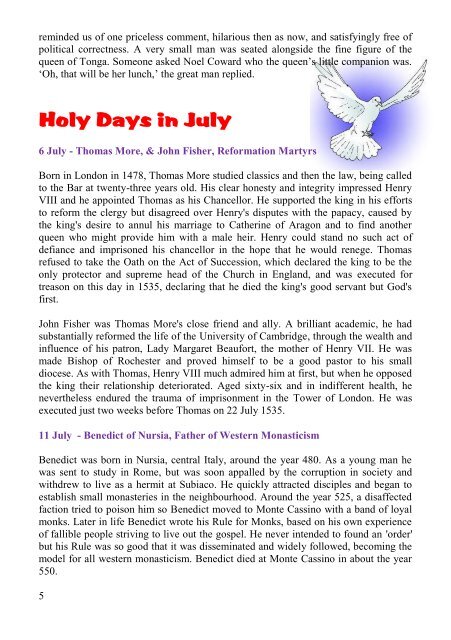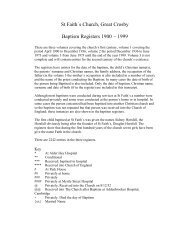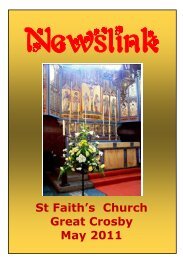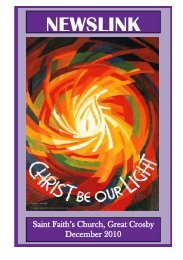July 2012 - St Faith's home page
July 2012 - St Faith's home page
July 2012 - St Faith's home page
Create successful ePaper yourself
Turn your PDF publications into a flip-book with our unique Google optimized e-Paper software.
eminded us of one priceless comment, hilarious then as now, and satisfyingly free ofpolitical correctness. A very small man was seated alongside the fine figure of thequeen of Tonga. Someone asked Noel Coward who the queen’s little companion was.‘Oh, that will be her lunch,’ the great man replied.Holy Days in <strong>July</strong>6 <strong>July</strong> - Thomas More, & John Fisher, Reformation MartyrsBorn in London in 1478, Thomas More studied classics and then the law, being calledto the Bar at twenty-three years old. His clear honesty and integrity impressed HenryVIII and he appointed Thomas as his Chancellor. He supported the king in his effortsto reform the clergy but disagreed over Henry's disputes with the papacy, caused bythe king's desire to annul his marriage to Catherine of Aragon and to find anotherqueen who might provide him with a male heir. Henry could stand no such act ofdefiance and imprisoned his chancellor in the hope that he would renege. Thomasrefused to take the Oath on the Act of Succession, which declared the king to be theonly protector and supreme head of the Church in England, and was executed fortreason on this day in 1535, declaring that he died the king's good servant but God'sfirst.John Fisher was Thomas More's close friend and ally. A brilliant academic, he hadsubstantially reformed the life of the University of Cambridge, through the wealth andinfluence of his patron, Lady Margaret Beaufort, the mother of Henry VII. He wasmade Bishop of Rochester and proved himself to be a good pastor to his smalldiocese. As with Thomas, Henry VIII much admired him at first, but when he opposedthe king their relationship deteriorated. Aged sixty-six and in indifferent health, henevertheless endured the trauma of imprisonment in the Tower of London. He wasexecuted just two weeks before Thomas on 22 <strong>July</strong> 1535.11 <strong>July</strong> - Benedict of Nursia, Father of Western MonasticismBenedict was born in Nursia, central Italy, around the year 480. As a young man hewas sent to study in Rome, but was soon appalled by the corruption in society andwithdrew to live as a hermit at Subiaco. He quickly attracted disciples and began toestablish small monasteries in the neighbourhood. Around the year 525, a disaffectedfaction tried to poison him so Benedict moved to Monte Cassino with a band of loyalmonks. Later in life Benedict wrote his Rule for Monks, based on his own experienceof fallible people striving to live out the gospel. He never intended to found an 'order'but his Rule was so good that it was disseminated and widely followed, becoming themodel for all western monasticism. Benedict died at Monte Cassino in about the year550.5








